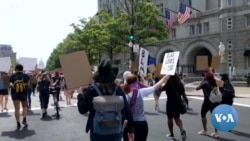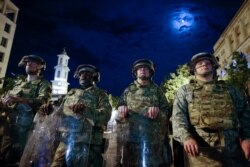Senior current and former U.S. defense officials are expressing concerns about the military being used for political purposes amid national protests against police brutality, while stressing the need for equal treatment for all Americans and upholding pledges to protect the constitutional rights of free speech and assembly.
“If we are to fulfill our obligation as service members, as Americans, and as decent human beings, we have to take our oath seriously,” said National Guard Chief Gen. Joseph Lengyel. “We cannot tolerate racism, discrimination, or casual violence.”
National Guard troops have been deployed in 31 states to assist local law enforcement responses to the protests that began a week ago with the death in police custody of African American man George Floyd.
The military’s presence is perhaps most prominent in the Washington area. President Donald Trump asked the nation’s governors to send National Guard troops to the District of Columbia, and Defense Secretary Mark Esper ordered 1,300 active duty troops to move to bases outside the capital where they were placed on a shortened alert status if requested and needed.
After several days of less tense protests in Washington, Pentagon officials Wednesday initially ordered about 200 of the active duty troops to return home. But after talks at the White House, Esper later reversed that decision.
Trump has emphasized the need for law and order as he called himself an “ally of all peaceful protesters.” He threatened to invoke an 1807 law allowing a president to deploy military forces domestically to suppress civil disorder in response to instances of looting and vandalism that have marred what have been widespread peaceful demonstrations.
“The Insurrection Act is a tool available,” White House Press Secretary Kayleigh McEnany told reporters Wednesday. “The President has the sole authority. And if needed, he will use it. But at this time, he's relying on surging the streets with National Guard.”
Esper told reporters Wednesday he does not support invoking the law.
“The option to use active duty forces in a law enforcement role should only be used as a matter of last resort, and only in the most urgent and dire of situations. We are not in one of those situations now,” he said.
Former Joint Chiefs of Staff Chairman Adm. Mike Mullen expressed his opposition in the magazine The Atlantic.
“I remain confident in the professionalism of our men and women in uniform. They will serve with skill and with compassion. They will obey lawful orders. But I am less confident in the soundness of the orders they will be given by this commander in chief, and I am not convinced that the conditions on our streets, as bad as they are, have risen to the level that justifies a heavy reliance on military troops,” Mullen wrote.
Former Pentagon leaders also objected to a series of events Monday in Washington, where riot police forcibly cleared protesters out of Lafayette Square, a public park in front of the White House, before Trump walked through the square with several members of his Cabinet, including Esper, as well as current Joint Chiefs Chairman Gen. Mark Milley. The president then stood in front of the historic church posing for photographs with a Bible.
Mullen said he was sickened “to see security personnel — including members of the National Guard — forcibly and violently clear a path” through the park to accommodate the president’s walk to the church.
“Whatever Trump's goal in conducting his visit, he laid bare his disdain for the rights of peaceful protest in this country, gave succor to the leaders of other countries who take comfort in our domestic strife, and risked further politicizing the men and women of our armed forces,” Mullen said.
Former Defense Secretary Jim Mattis, also writing in The Atlantic, said when he joined the military and swore an oath to defend the Constitution, “Never did I dream that troops taking that same oath would be ordered under any circumstance to violate the Constitutional rights of their fellow citizens — much less to provide a bizarre photo op for the elected commander in chief, with military leadership standing alongside.”
Esper defended his role in what happened Monday, saying he was unaware of law enforcement plans for clearing the park, and did not know exactly where the group was heading or what the plan was once they arrived. He said his intention was to speak with the National Guard troops at the park.
Esper said there is a “political tone” to the protest response and that his department faces a challenge as the country approaches national elections in November.
“I've been speaking about the importance of staying out of politics by remaining apolitical to my leadership since I took office. I reinforced it when I came in, when we started the new year, and I've talked about it several times since then. But this will be the ongoing challenge,” he said.
Mattis said he was “angry and appalled” as he watched the events of this week unfold.
“Militarizing our response, as we witnessed in Washington, D.C., sets up a conflict—a false conflict—between the military and civilian society. It erodes the moral ground that ensures a trusted bond between men and women in uniform and the society they are sworn to protect, and of which they themselves are a part,” he said.
Mattis, who resigned in 2018 over Trump’s decision to withdraw U.S. troops from Syria and other foreign policy disagreements, further called for national unity to overcome the current crisis, while criticizing Trump, saying the country is “witnessing the consequences of three years without mature leadership.”
“Donald Trump is the first president in my lifetime who does not try to unite the American people—does not even pretend to try. Instead he tries to divide us,” Mattis wrote. “We can unite without him, drawing on the strengths inherent in our civil society. This will not be easy, as the past few days have shown, but we owe it to our fellow citizens; to past generations that bled to defend our promise; and to our children.”
Trump initially praised Mattis at the end of his tenure, thanking him for his service and crediting him with helping to boost NATO allies’ military spending. But Wednesday’s publication of Mattis’ comments drew harsh tweets from Trump.
“His primary strength was not military, but rather personal public relations. I gave him a new life, things to do, and battles to win, but he seldom “brought home the bacon”. I didn’t like his “leadership” style or much else about him, and many others agree. Glad he is gone!”












